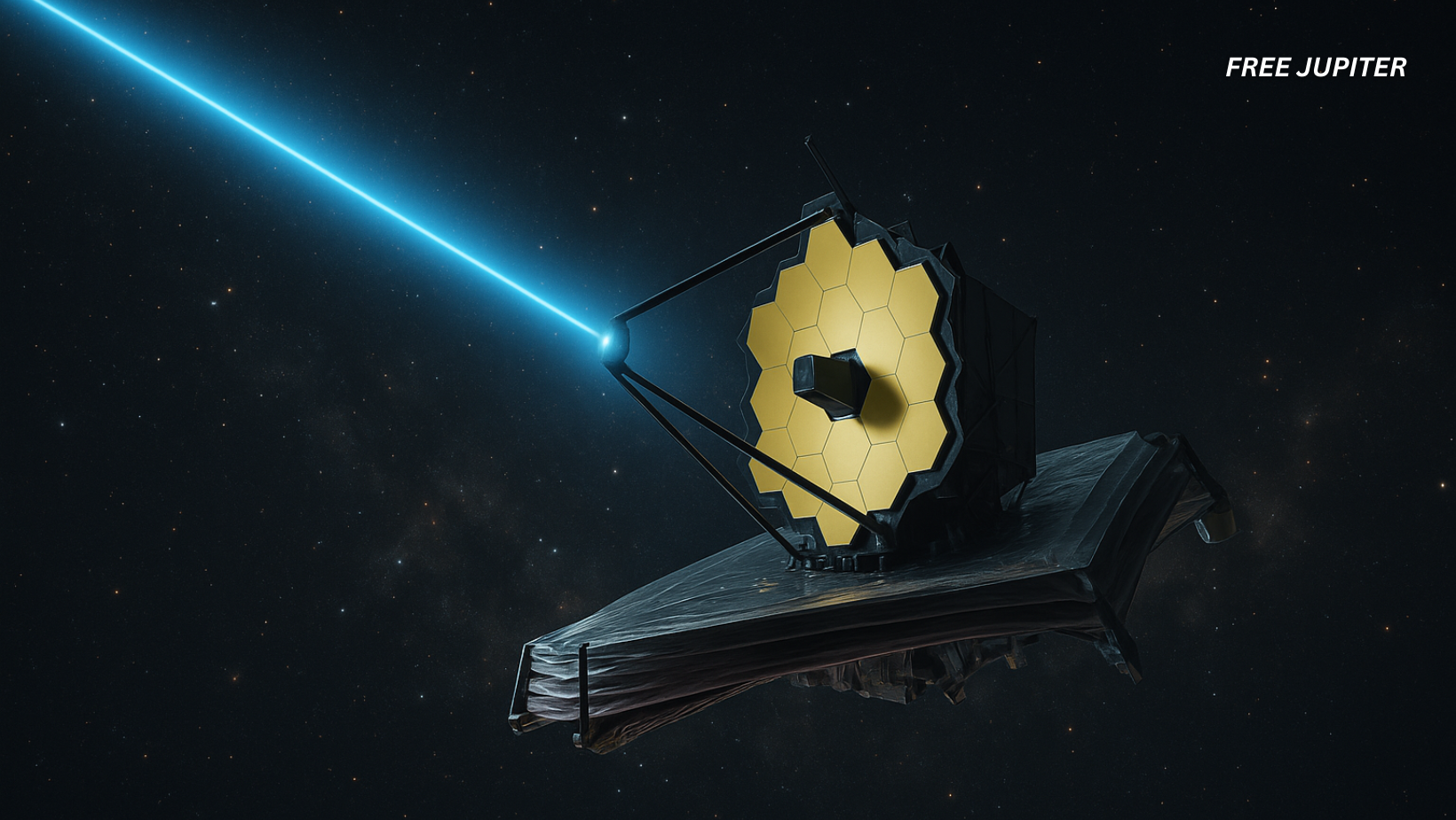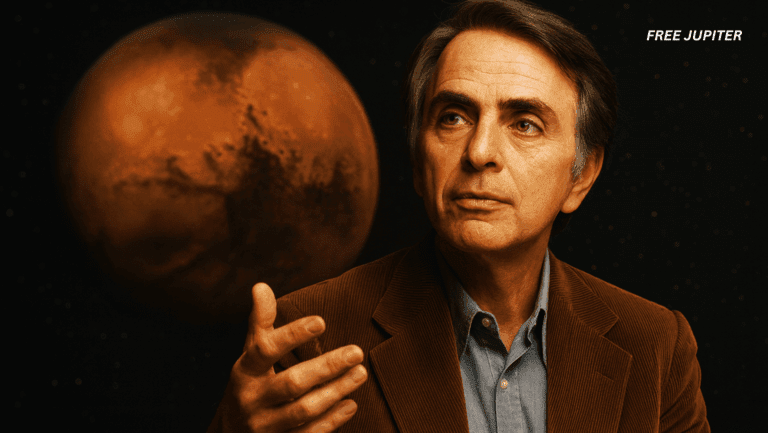Note: FreeJupiter.com shares general info for curious minds 🌟 Please fact-check all claims—and always check health matters with a professional 💙
The universe is full of surprises, but every once in a while, something happens that leaves even seasoned astronomers rubbing their eyes in disbelief. Recently, one such surprise arrived in the form of a blindingly bright flash of radio energy—so intense that researchers quickly dubbed it RBFLOAT, short for “Radio Brightest Flash Of All Time.”
With help from the James Webb Space Telescope (JWST) and Canada’s ambitious CHIME telescope system, astronomers not only caught this dazzling burst but also traced it back to its possible origin for the very first time. This discovery may be a breakthrough in solving one of the great mysteries of modern astronomy: what exactly is creating fast radio bursts, or FRBs?
What Exactly Is a Fast Radio Burst?
Before diving into the discovery, let’s slow down and talk about FRBs. Imagine you’re listening to an old radio and suddenly hear a sharp, loud “pop” that vanishes almost instantly. That’s a little like what astronomers detect with FRBs—a brief spike of radio energy that bursts onto the scene and then disappears within milliseconds.
Despite their short life span, these bursts are astonishingly powerful. In a fraction of a second, an FRB can release more energy than our Sun produces in days. Think of it like striking a match that outshines a bonfire.
Since the first FRB was identified in 2007, astronomers have detected over 1,000 of them from across the cosmos. Some repeat, popping up in the same location over and over, while others appear once and vanish forever. The mysterious nature of these flashes has kept scientists guessing.
The leading theory points to magnetars—exotic neutron stars with magnetic fields so strong they could strip the credit cards right out of your wallet if you somehow stood nearby. But magnetars aren’t the only suspects. Colliding stars, black holes, and even exotic phenomena we haven’t yet discovered have all been proposed.
Read more: NASA’s James Webb Telescope Directly Photographs Saturn-Like Exoplanet For The First Time
The Record-Breaking Burst
Then came RBFLOAT. In March 2025, Canada’s CHIME (Canadian Hydrogen Intensity Mapping Experiment) telescope array caught this extraordinary signal. CHIME is a unique instrument: instead of looking like a traditional telescope with one giant dish, it has more than 1,000 radio receivers arranged in large, trough-shaped antennas. This setup makes it perfect for spotting FRBs, and over the years, it has become the world’s leading FRB hunter.
But RBFLOAT was no ordinary detection. It was the brightest single FRB ever recorded by the facility. Its intensity was so extreme that astronomers suspected it had to come from somewhere relatively close by in cosmic terms—possibly within just a few hundred million light-years.
To put that in perspective: light from our Sun reaches us in about eight minutes. Light from the nearest star system, Alpha Centauri, takes about four years. RBFLOAT traveled 130 million years before its signal reached Earth. While that sounds unfathomably distant, in the vastness of the universe, it’s practically a neighbor.
How Do You Track a Millisecond-Long Flash?
Detecting a burst is one thing. Pinpointing its exact source is another challenge entirely. That’s where CHIME’s newer Outrigger array came into play. These are partner telescopes spread across North America, stretching from California to British Columbia. By comparing the timing of the signal across these different sites, astronomers were able to triangulate RBFLOAT’s position with remarkable accuracy.
They narrowed its origin down to a galaxy called NGC 4141, tucked inside the well-known Big Dipper constellation. Even more impressively, they confined the burst’s location to a region just 45 light-years across. That might sound huge, but considering that our own galaxy, the Milky Way, is about 100,000 light-years wide, it’s a very small patch of sky to focus on.
One researcher described the precision as being equivalent to spotting a quarter from 100 kilometers (62 miles) away. That’s the astronomical version of threading a needle blindfolded—while standing on a moving train.
Enter the James Webb Space Telescope
With the burst’s neighborhood identified, it was time for JWST to flex its muscles. Launched in late 2021, JWST is the most advanced space telescope ever built, capable of detecting faint glimmers of light from the earliest galaxies in the universe. Its specialty lies in infrared vision, allowing it to see through dust clouds and capture details invisible to other telescopes.
When JWST zoomed in on the region of NGC 4141 where RBFLOAT originated, it found something fascinating: a bright object glowing in infrared light exactly at the burst’s location. Even more intriguingly, the telescope could resolve individual stars surrounding the site—something no previous telescope had been able to do for an FRB.
This level of clarity gave scientists their first real glimpse of the environment where such a burst could be born.
Read more: NASA’s James Webb Telescope Witnesses The Birth of a Solar System
The Prime Suspects: Stars in Crisis
So, what was JWST actually seeing? The data suggested two possibilities:
- A red giant star – a star at the end of its life, swollen and unstable, shedding layers of gas into space.
- A massive middle-aged star – many times larger than the Sun, still burning brightly but heading toward an eventual dramatic death.
Neither of these candidates fit the standard profile of an FRB source on their own. But what if one of them had company?
The team proposed that a hidden companion star—likely a neutron star or magnetar—could be orbiting nearby. If so, the two stars could be interacting in dramatic ways. The smaller but far denser neutron star might be pulling matter away from its larger partner, triggering violent outbursts that manifest as FRBs.
There’s also a second possibility: one of the massive stars in the surrounding cluster may have already collapsed into a magnetar, too faint for JWST to see directly. If that’s the case, it could have unleashed RBFLOAT in a solo act.
Why This Matters for Astronomy
This discovery is more than just another astronomical curiosity—it’s a genuine turning point. Until now, astronomers struggled to trace FRBs back to specific galaxies, let alone individual star systems. The bursts are simply too brief and too unpredictable.
But with CHIME’s ability to detect and precisely localize FRBs, and JWST’s unmatched ability to zoom in and study their environments, scientists now have a new toolkit to investigate these cosmic puzzles.
According to lead researcher Peter Blanchard of Harvard University, this was the first time astronomers could resolve individual stars around an FRB. That means we’re no longer just guessing at the environments where these bursts happen—we’re starting to see them directly.
This changes the game. If astronomers can repeat this process with other FRBs, they might finally pin down the conditions that make these blasts possible. Are they always linked to magnetars? Do they require binary star systems? Or are multiple pathways possible? Each new detection will add pieces to the puzzle.
What RBFLOAT Teaches Us About the Universe
Beyond the thrill of discovery, studying FRBs has broader implications for science. These bursts can act like cosmic beacons, helping astronomers map the distribution of matter across the universe. As their signals travel through space, they interact with gas and plasma, leaving behind clues about what lies between galaxies.
In other words, FRBs could become tools for probing the “invisible scaffolding” of the universe—the vast web of gas and dark matter that shapes how galaxies form and evolve.
RBFLOAT, with its extraordinary brightness, is a perfect example. Its sheer power makes it easier to study in detail, potentially offering insights not just into its source but also into the cosmic medium it passed through on its journey to Earth.
The Road Ahead
For now, the exact cause of RBFLOAT remains uncertain. Was it a binary system involving a hungry neutron star? Was it an isolated magnetar flexing its magnetic might? Or something else entirely?
Whatever the answer, astronomers are excited. This discovery has shown that we now have the tools to hunt down these fleeting flashes with unprecedented precision. Each new FRB traced back to its birthplace brings us one step closer to understanding not just these mysterious signals, but the wild, explosive lives of stars themselves.
As Blanchard noted, even if the specific link to a star in NGC 4141 proves coincidental, the process has already taught us a tremendous amount about how to study FRBs. The chase is on, and the universe is more than willing to keep throwing curveballs our way.
Read more: The “Strongest Evidence So Far” of Alien Life Has Been Found in James Webb Data
A Cosmic Mystery With a Human Touch
It’s worth remembering that all of this began with a blip—a millisecond-long burst that could have easily gone unnoticed in the sea of cosmic noise. Instead, it sparked an international collaboration between telescopes, scientists, and cutting-edge technology, leading us to glimpse a possible origin story billions of years in the making.
For the average stargazer, the idea of light traveling 130 million years before reaching Earth can feel overwhelming. But moments like this remind us that the universe is not just distant and abstract—it’s dynamic, restless, and sometimes willing to shout across unimaginable distances.
And thanks to tools like CHIME and JWST, we’re finally starting to hear it loud and clear.
Image: GPT-5o










